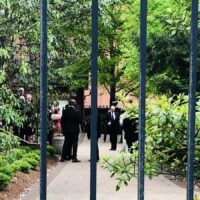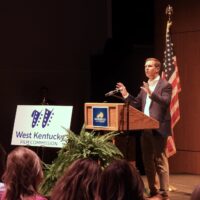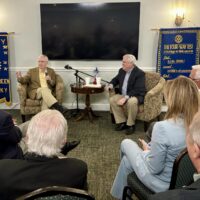When walking down Mayfield’s Broadway Street — just one of the many spots around western Kentucky devastated by a tornado system that ravaged across over 200 miles this weekend — it’s easy to get lost in the horrific aftermath of the storm, to be overwhelmed by the sheer devastation all around. Bricks ripped out of mortar, doors blown out, roofs ripped off and some buildings completely toppled.
When meteorologist Kelsey Angle looks at a scene like this, he sees something beyond the horror. He sees data, noting the uprooted trees and snapped trunks, the shingles stripped off and the amount of broken glass.
“All of those are indication of damage indicators that we can correlate to an estimated windspeed with this particular tornado,” Angle explained. “A lot of damage in tornadoes is similar, and that’s why we use the particular damage indicators and degree of damages that we use. So that we’re consistent in how we record from a historical aspect the impacts and the strength of a tornado.”
These damage indicators are data points organized by category of structure (e.g. a one or two family homes, barns, transmission line towers) or environmental feature (hardwood tree) and how much damage was done to them. The National Weather Service uses quantitative data to more accurately determine where any specific tornado falls on the Enhanced Fujita or EF scale.
A National Weather Service representative said the tornado that went through Mayfield was at least an EF-3 during a briefing this weekend. She did say the tornado had the potential to be upgraded in other places along its path. Other briefings have stated the number of tornadoes in the system to be four, but Angle believes it’s possible there were several more. The NWS worker has seen indicators of varying levels during his survey work so far.
“As you get more into the core of where the tornado was the strongest, that’s where we’re seeing more significant structural damage with total loss of roof. Also seeing walls that have collapsed, power poles that have been snapped, electric lines completely downed, and some structures with just debris down to the foundation in some very isolated locations closer to downtown Mayfield,” Angle said. “The damage certainly varies (in this tornado path). We’ve seen EF-0 damage, EF-1, EF-2, EF-3 damage. This is going to be a long process.
“We’re continuing to assess in regards to the high-end EF-3, EF-4 and if any EF-5 damage has occurred with this particular tornado.”
Accompanying the 15-year-veteran in Angle is Cory Rothstein. Rothstein started working with the National Weather Service just three years ago, and he was taken by the human impact of this storm.
“The biggest thing that’s stuck with me is just the devastation. Seeing peoples’ livelihoods, their lives, change completely on a dime. It’s heartbreaking. It is hard to look at, and I think a testament to what we’ve been trying to do to protect the public, both lives and property, is just how many people were able to be saved with this event,” Rothstein said. “How many people got warning with well in advance lead time to be able to seek shelter and get to safety once a tornado of this strength came through.”
Angle said studies like this are essential to better arm meteorologists to forecast dangerous weather events. This will aid in hopefully preventing greater tragedies in other communities.
“It does make meteorologists better,” he said. “It helps them correlate what they’re seeing from a date standpoint to the impacts and the magnitude of a particular storm.”
Angle thinks it will take at least through the end of the week for the completion of this survey, but he knows people in Mayfield will be dealing with the aftermath for much longer.
“Lives are changed in just a matter of seconds and it certainly takes days, weeks, months, even years, from a recovery standpoint to rebuild to start to heal and move forward,” he said.
The total destruction of parts of Mayfield left lifelong Graves County resident Josh Riley in disbelief this weekend.
“(My aunt and uncle’s) house is just annihilated. It’s almost like the pictures of Hiroshima and Nagasaki out here,” Riley told WKMS. “Some of these buildings have been here since the late 1800s and early 1900s and they’re just wiped off the face of the Earth. I mean, they’re done. There’s no rebuilding them.”
Local business owner Darryl Fulcher is one of those who will have to rebuild. He recalls getting a text message early Saturday telling him his septic tank company had been destroyed. A crew started helping him clean up what was left of his workshop Monday morning.
“I see a little daylight at the end of the tunnel so I can’t give up,” Fulcher said. “We’re Americans. We’re gonna pull together and we’re gonna do this.”





